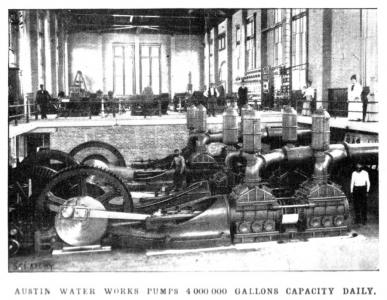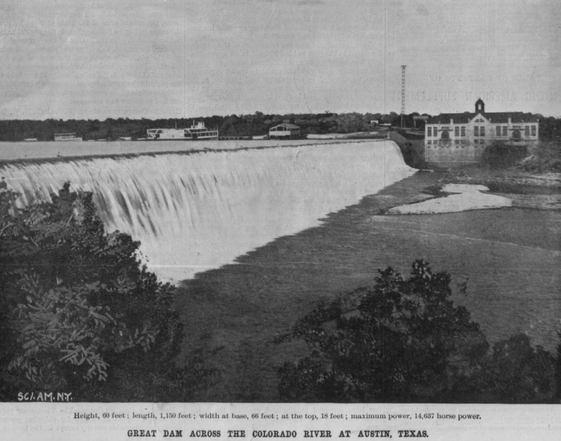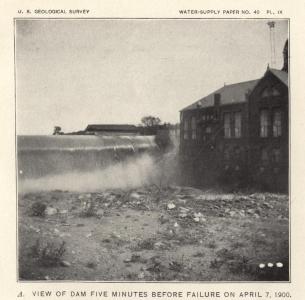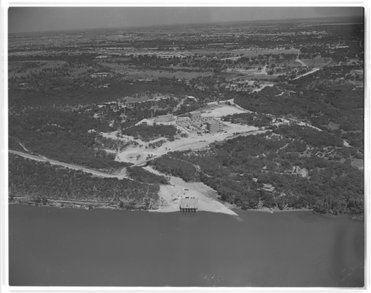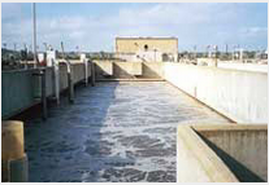Austin water company
|
Austin had to balance its desire for water and wastewater with its tenuous economic conditions. Since it could not initially afford to build its own water and wastewater infra- structure, it granted the privilege to private companies.
The City Water Company, owned by principals outside of Austin, was chartered in 1875 and placed in operation in 1876. It was granted a 25-year franchise in 1877. In 1882, City Water Company diversified to provide electric lighting as well. Its first efforts provided power for 1,600 lights, primarily for residences. The company expanded its role to street lighting and electricity for motor power in 1887, which would largely curtail further expansion of gas street lamps in Austin. There were other small competing electric utilities that tried to establish themselves, but by 1888, the (renamed) Austin Water, Light and Power Company was the town’s main provider of water and electricity.[10] |
figure 3.Austin Water works pumps 4000000 gallon capacity daily
|
the austin dam
|
figure 4.The Austin Dam at 1896
|
Long before the scientific mind, with the aid of capital, had determined to utilize the vast volume of water that is precipitated with such tremendous force at Niagara, the citizens of Austin, Texas, had begun the construction of a great dam across the (Texas) Colorado River, two and a half miles above the city limits, Its purpose was to furnish light and water for the city and incidentally a considerable surplus power for other uses. The idea was not a new one. Examples can be found in many places.[11]
J.T.Fanning, of Minneapolis, a well-known hydraulic engineer, who was consulted on the feasibility of the plan, said in his report : " On inspection of the new dam in progress, in company with the board, I was impressed with the magnitude of the engineering work, and especially with the exceeding great responsibility which the city has committed to the Board. I find that the dam which you have projected will raise the water of the river 60 feet above the former low water level, that it will have a maximum height to its crest of 70 feet and that its crest overfall will be about 1,125 feet long, and that the dam will flow the water twenty-five or thirty miles up the valley, creating an extensive lake. This dam is being constructed of solid masonry and is faced on each side with large blocks of excellent granite.[11] |
the failure of the austin dam
|
After the dam was completed the project was found to be only partially successful, as the amount of water in Colorado River fell far short of the original predictions. There was at the inception a lack of hydrographic knowledge, especially in regard to the minimum flow of the river, and other information, now known to be vital to the proper location of the dam, was not obtained. Finally, during the great flood of April 7, 1900, the dam was destroyed, with great loss of life and property.[11]
|
figure 5. Five minutes before the Austin Dam failure
|
water treatment
|
figure 6.An aerial view of the city filtration plant in Austin, the Davis Water Treatment Plant
|
In 1923, Dr. E.P. Schoch, a chemical engineering professor at the University of Texas at Austin, created a simple chemical treatment that used lime to turn river water into drinkable water. The Green Water Treatment Plant was built in 1925 to use this treatment method.
"Modern" water treatment had become a reality in Austin. The City decommissioned the Green Water Treatment Plant September 2008; currently, the Davis and Ullrich Water Treatment Plants currently serve the City, and Water Treatment Plant 4 is under construction.[12] |
wastewater treatment
|
The City's first wastewater treatment facility was built in 1919 using a tank to settle wastewater solids. In 1937, the tank system was replaced by the Govalle Wastewater Treatment Plant, a revolutionary facility using a relatively new treatment process using activated sludge. The Govalle Plant was decommissioned October 2006, and Austin is currently served by the Walnut Creek and South Austin Regional Wastewater Treatment Plants.The plants receive wastewater flow from Austin Water Utility's sanitary sewer collection system and treat it before returning it to the Colorado River. Austin Water Utility's biosolids facility, Hornsby Bend, receives sludge generated by the treatment processes at the wastewater plants and uses it to create compost for land application and public sales.[12] |
figure 6.South Austin Regional Wastewater Treatment Plant
|
References:
[10]Headwaters: The Early History of Austin’s Water and Electric Utilities
http://environmentaldirectory.info/PDFs/History-of-Utilities-AED2013.pdf
[11]The Austin Dam
http://www.machine-history.com/Austin%20Dam%201896
[12]WATER AND WASTEWATER HISTORY
http://www.austintexas.gov/department/water-and-wastewater-history
figure 3.Austin Water works pumps 4000000 gallon capacity daily
http://www.machine-history.com/Austin%20Dam%201896
figure 4.The Austin Dam at 1896
http://www.machine-history.com/Austin%20Dam%201896
figure 5. Five minutes before the Austin Dam failure
http://www.machine-history.com/Austin%20Dam%201896
figure 6.An aerial view of the city filtration plant in Austin, the Davis Water Treatment Plant.
http://texashistory.unt.edu/ark:/67531/metapth19413/
figure 7.South Austin Regional Wastewater Treatment Plant
http://www.austintexas.gov/department/wastewater-treatment-plants
[10]Headwaters: The Early History of Austin’s Water and Electric Utilities
http://environmentaldirectory.info/PDFs/History-of-Utilities-AED2013.pdf
[11]The Austin Dam
http://www.machine-history.com/Austin%20Dam%201896
[12]WATER AND WASTEWATER HISTORY
http://www.austintexas.gov/department/water-and-wastewater-history
figure 3.Austin Water works pumps 4000000 gallon capacity daily
http://www.machine-history.com/Austin%20Dam%201896
figure 4.The Austin Dam at 1896
http://www.machine-history.com/Austin%20Dam%201896
figure 5. Five minutes before the Austin Dam failure
http://www.machine-history.com/Austin%20Dam%201896
figure 6.An aerial view of the city filtration plant in Austin, the Davis Water Treatment Plant.
http://texashistory.unt.edu/ark:/67531/metapth19413/
figure 7.South Austin Regional Wastewater Treatment Plant
http://www.austintexas.gov/department/wastewater-treatment-plants
